Written by Mary DeLuca and Jamie Wagner
The student journey in community college has always been a bit circuitous. But now, more than ever, we need to show students that we have their backs.
The problem is that student needs and motivations are changing drastically. So how can you tap the latest data and leverage your creativity to better serve students? And how can you align your messaging to meet learners wherever they are in their journeys?
In this blog, we’ll share six tips for bolstering student retention that will
- Identify critical points in the student journey where learners are most vulnerable …
- Provide best practices for clear and concise student messaging …
- And ensure all students are feeling both encouraged and supported on campus.
Get ready to get creative amidst the chaos and the ongoing pressures of increasing expectations and decreasing resources. Read on to find insightful research and resourceful messaging techniques to help you reach, engage, and motivate your students.
Understanding the Student Journey to Make Real Connections
How can you engage and motivate learners on their student journey?
The truth is that you really can’t unless you take the time to truly understand them. And often, that understanding starts with data.
Interact’s Media Prefs survey is turning “sweet 16” in 2022, and we’re sharing our student data with all colleges to celebrate … for free!
Media Prefs covers many topics but primarily focuses on the media and communication preferences of community college students nationwide. The research holds a wealth of knowledge that will help you reconnect with and learn more about your students.
This past fall, the Media Prefs survey yielded 21,000+ student responses from almost 100 colleges across 25 unique states — so there’s a lot to talk about!
84% of Students Believe They Will Graduate, but Only 20% Make It
So, what is the latest Media Prefs data telling us? For years, our research has shown that students are extremely optimistic that they will stay at your college until they graduate. 84% of students indicated that they are either likely or very likely to do so. However, from Mark Kantrowitz’s research highlighted by Forbes, we know that less than 20% of community college students make it to the finish line.

Student retention has been a struggle facing all colleges. So, what are some of the issues and barriers your students face?
Top Student Journey Challenges
Financial reasons, mental health, work, and family emergencies are what students are up against most frequently.
But on campus, they’re also fighting to understand some of your most basic processes — like registering for classes.
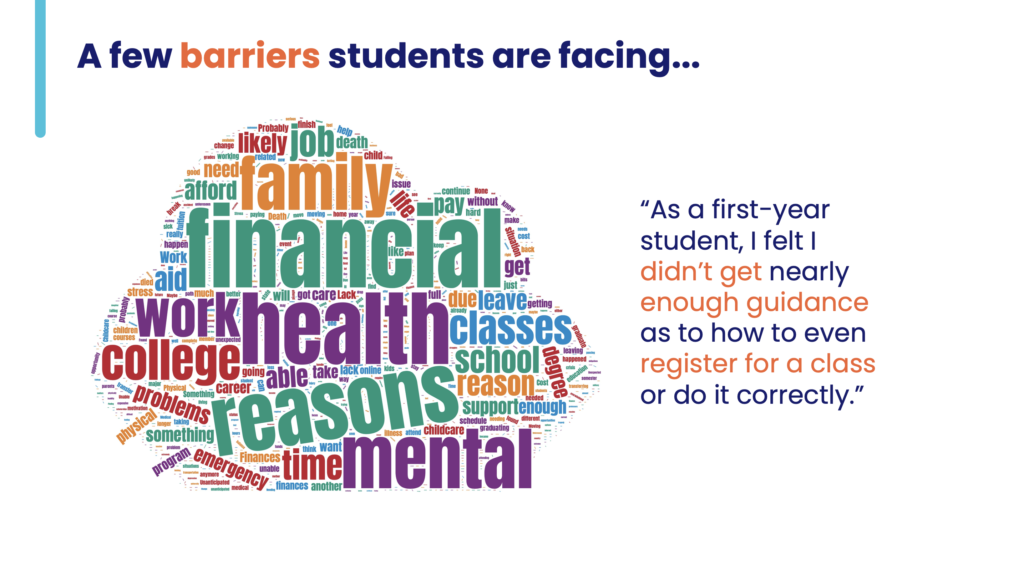
With the pandemic, students told us that they were struggling with getting in-person support for things like financial aid and advising.
But above all else, they have a mountain of self-doubt. Students are constantly wondering if they’re even good enough to be at your college.

So, how can you let students know that they’re valued members of your community and that you believe in them?
How to Craft Messages of Encouragement and Support to Bolster the Student Journey
Ready to get inspired? Take Oakland Community College — the school works small messages of encouragement and support into their social media feeds.
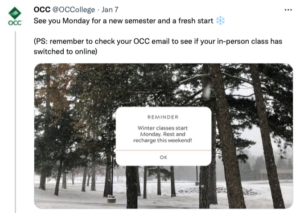
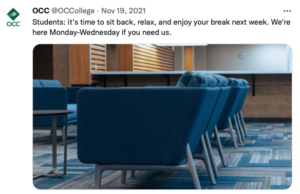
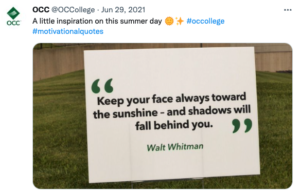
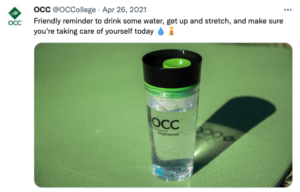
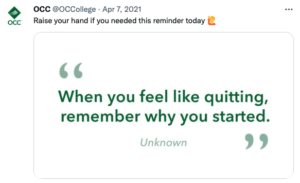
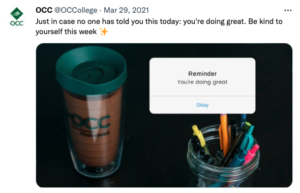
Many times, social media posts are so focused on college content, programs, and important dates that we forget to offer encouragement. And yet, we know students really appreciate a friendly motivational push for self-care or a reminder that they’re doing great. Any incentive to keep them pressing forward is a win.
When a college invests in supportive messaging, students tell us that it’s effective. These efforts also work extremely well for older students who may feel less encouraged and supported by the college in the first place.

We’ll talk about the nuts and bolts of rafting messages a little bit later. But next, let’s dive deeper into the student journey.
The Ins and Outs of the Student Journey
We know that the student journey is complex. It can take a year or more for most to go from even the inquiry stage to actually enrolling.
Here’s what we wish the student journey looked like. A smooth, direct, frictionless passage from our messaging to every student’s graduation and success.

But the student journey in the real world looks more like a tangled, jumbled mess.
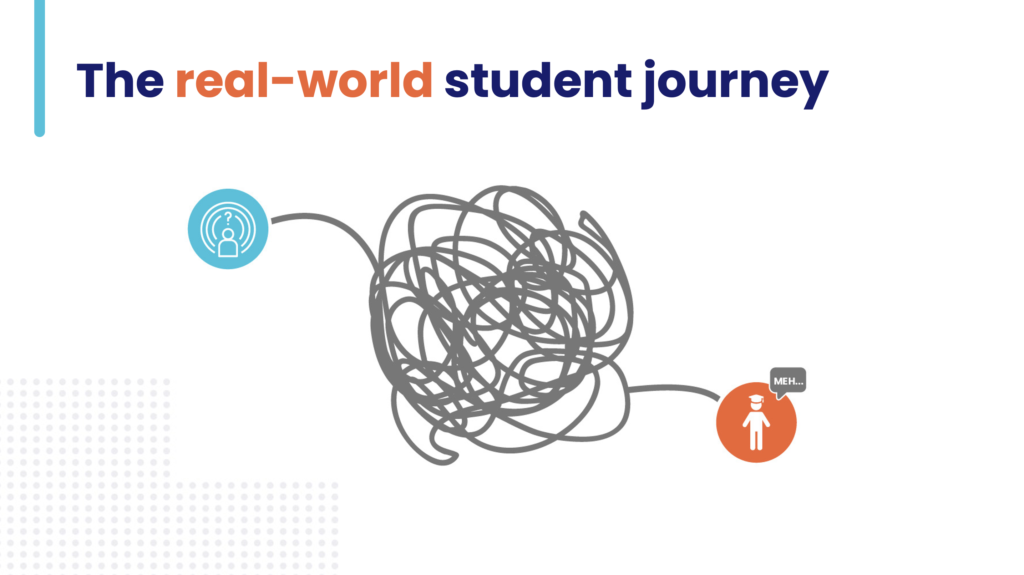
Students are constantly being bombarded, sidetracked, and frustrated. That’s why you need to create friendly, emotional connections that nudge them along at each stage.
Ready to craft those encouraging messages? The following are six simple tips to help you reach more students and strengthen your enrollment and retention strategies.
Six Creative Techniques to Strengthen Persistence During the Student Journey
1. Creating Connections: Inspiring the Dream
If you just bog students down with technical to-do lists and forms, they’ll be bound to fail. Instead, make a vital emotional connection at each point of inquiry.
With every single engagement …
- Inspire their dream
- Connect that dream to your college
- And motivate them to take that next step in their decision to enroll!
For example, check out this recruitment campaign video we helped produce for Louisiana Delta Community College. It’s a wonderful example of aspirational messaging:
“Dreams have power. They inspire us to reach higher … They drive us to go farther … And they challenge us to see what could be. Dreams can start anywhere — but where they go is up to you. And when you’re ready to live your dream, we’ll be here with the training and guidance you need to see it through. Louisiana Delta Community College: Dare to Dream.”
Louisiana Delta Community College
2. Don’t Abandon the Dream in the Application Stage
The application stage is where most colleges make the mistake of moving away from the kind of inspirational messaging we just saw in that video to mechanical and technical communication.
Essentially, they abandon “the dream” to focus on the “process.”
Communication often becomes impersonal and can discourage students. We see this frequently in our communication audits we conduct for colleges: There’s a lot of text-heavy content devoid of emotion. Take the following two examples:
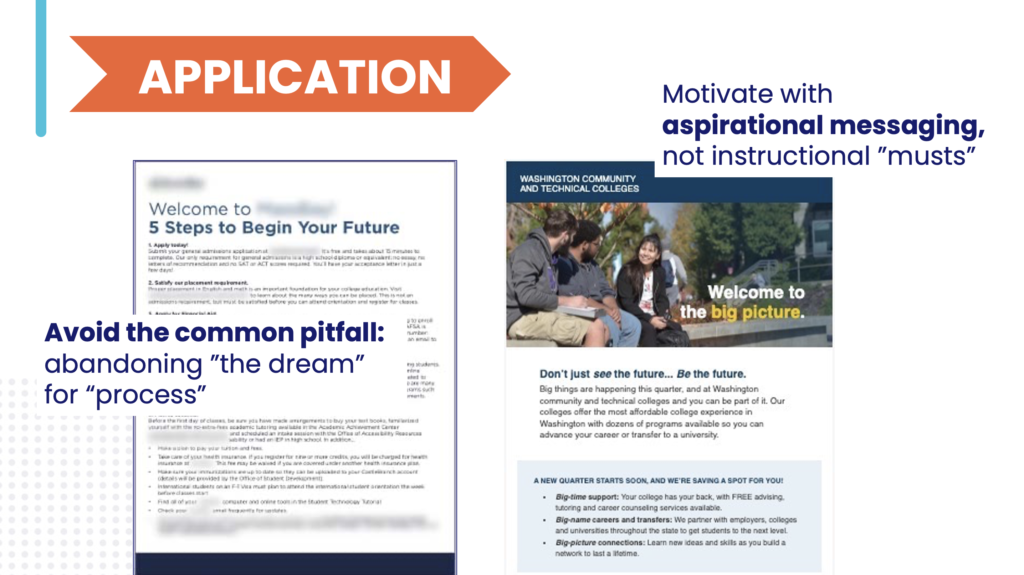
Unlike the typical, copy-heavy example on the left, the prospective student email on the right is warm and welcoming in both its visual appeal and language. It makes students feel good about their decision to enroll at Washington Community and Technical Colleges.
Take a look at your application communications. Are there places you can take a warmer tone and keep inspiring the college dream?
3. Don’t Miss Students During Onboarding
Onboarding is where most prospective students fall out, with 50-70% lost during conversion. At this stage, students are stressed with complicated, unfamiliar processes, like testing, registering for classes, and paying bills.

That’s why it’s critical during this time to work even harder to make students feel welcomed and valued.
In the onboarding process and college spoofing reviews we conduct, you’d be surprised at how many college offices never even ask for the student’s name when we call as “secret shoppers!”
Calling someone by their name may seem small, but it is incredibly important to make that needed emotional connection and build trust.
Think about your onboarding process and ways you can make the student journey just a little friendlier.
4. Overcoming Onboarding Challenges
Students experience several stressors during onboarding that lead to a fight-or-flight response. Understanding these issues can help you adjust your communication approach to overcome stressors and help students build up their grit and resilience.
For example, when students get conflicting information about their next steps, they can feel frustrated and start to doubt their decision.
You can address this by reviewing your messages that are going out from different offices on campus. If needed, rewrite those communications so that you’re providing students with clear, consistent, and helpful guidance.
5. Keep Up Kind Connections to Overcome Retention Hurdles
Retention is a major concern for colleges. And we need to look at the issues for students both within and between semesters.
When students start classes, more self-doubt creeps in as their work is judged and graded. That’s when nudges of encouragement from their faculty can make a world of difference and motivate them to persist.
But the single most dangerous part of the student journey is between semesters.
Most colleges lose 30% of their students between fall and spring, and another 40 to 60% between spring and the next fall.

Part of the reason for this loss is that colleges go silent between semesters. Or, schools only send transactional messaging reminding them of registration deadlines or paying a bill. Not so warm and fuzzy!
So, we need to avoid this pitfall by keeping up encouragement and building connections between and within semesters.
6. Graduation: Challenging Faculty to Rekindle Their Commitment
Graduation is an event to celebrate that every single student should experience at your college. Unfortunately, as we mentioned earlier, less than 20% of students graduate.
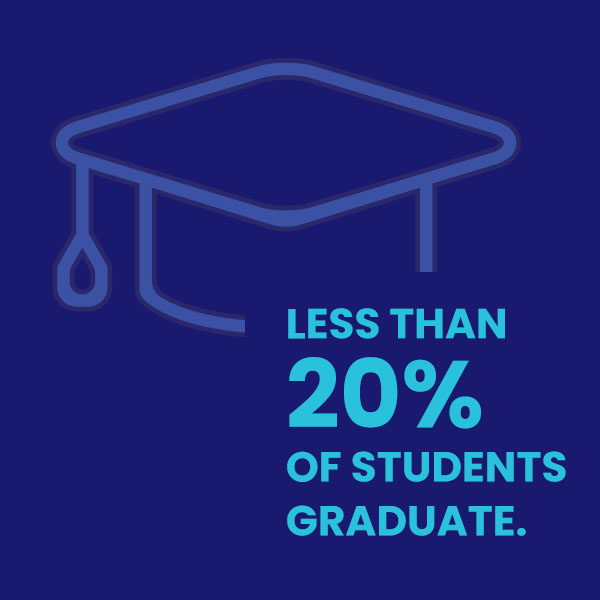
To help students make it to the finish line, keep connecting them to their dream of a degree. And that means challenging faculty and staff to find new ways to support students, especially your vulnerable populations.
It’s about more than just sending the right message at the right time. You need to keep reminding your internal community of their commitment. Make sure your faculty’s support comes through in every way they engage with students.
Key Takeaways for Creative Outreach and Retention across the Student Journey
Bolstering the Student Journey with Six Simple Tips:
- Creating Connections, Inspiring the Dream: Remember to keep on inspiring students’ dreams with every single engagement.
- Don’t Abandon the Dream in the Application Stage: While the process is important, remember to continue to inspire.
- Don’t Miss Students During Onboarding: Colleges lose 50-70% of students during conversion, so work extra hard to make students feel valued during this time.
- Overcoming Onboarding Challenges: Remember to review and rewrite your onboarding communications to provide clear, consistent, and helpful guidance.
- Keep Up Kind Connections to Overcome Retention Hurdles: Reinforce encouragement within and between semesters to overcome student doubt.
- Graduation and Challenging Faculty to Rekindle Their Commitment: Only about 20% of students typically graduate. So be sure to get your faculty on board to support your learners, especially your vulnerable populations.
Stay tuned to turn these insights into action! We’ll highlight strategies for building creative connections with students to garner real retention results, coming in part two:
Want to Engage Students? Boost Retention in Education with Relatable, Emotional Messaging.
Would you like extra support in building your enrollment and retention strategies? We’re always happy to help. Book a free consultation, or check out our services page to learn more!
About Mary DeLuca, MA, Vice President of Client Development
With 30 years of community college experience, Mary DeLuca is eager to share her creative skills and strategic insights with other 2-year college professionals. Mary developed a nationally respected communications department and successful college brand from the ground up during her leadership tenure at Maryland’s Community College of Baltimore County (CCBC). Her team won an impressive collection of more than 100 NCMPR Paragon and Medallion awards. Mary has always had a flair for marrying words and images, accentuated by a Master of Arts degree in publications design, which inspires her work as an impactful organizational storyteller.
About Jamie Wagner, Executive Director of Interact’s Media Preferences Research
With over 10 years of experience in project management, event marketing, and community outreach, Jamie Wagner is an expert at building relationships and making the research experience enjoyable and stress-free. Jamie is a graduate of the University of Wisconsin-La Crosse, where she studied marketing and organizational and professional communication. She’s proud to say that Media Prefs is celebrating its sweet 16 this year!
About the Illustrator and Designer, Jasmine Tully
Jasmine Tully lends her practiced and inspired skillsets in helping our clients tell vivid stories. As a Graphic Designer, Jasmine supports Interact’s award-winning creative team, creating and executing marketing materials, templates, publications, web pages, and more. With an associate degree in graphic design from Western Tech, Jasmine also has a versatile background in childcare, child art, and non-profit work. When she’s not designing, she’s drawing up loops as an avid crocheter, knitter and seamstress.



